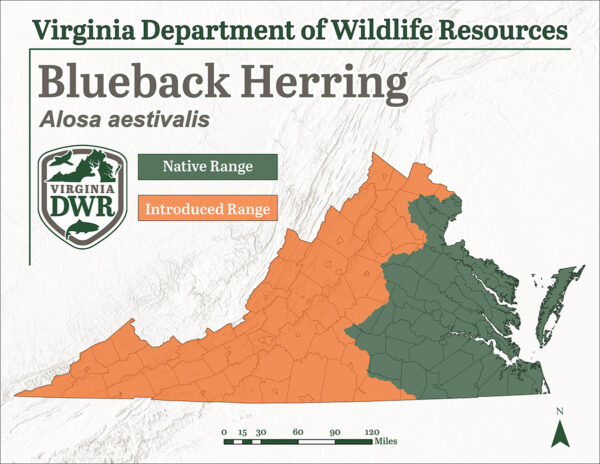Fact File
Scientific Name: Alosa aestivalis
Classification: Fish, Order Clupeiformes, Family Clupeidae
Conservation Status:
- Species of Greatest Conservation Need-Tier 4a on the Virginia Wildlife Action Plan
Size: Blueback Herring typically range from 8 to 11 inches in Virginia, but larger specimens can surpass 15 inches in length
Life Span: Blueback Herring can live for about 9 years
Identifying Characteristics
- Elongated body, tapering quickly near the caudal fin (tail)
- Eye diameter is equal in size to the length of the snout
- Deeply forked caudal fin
- Silver in color along the sides, with hues of purple and blue in certain lighting
- An elongated anal fin in the shape of a sickle
- A sharp keel along the underside
How to Discern from Similar Looking Species

Four anadromous clupeids captured during a Virginia DWR Fish Passage efficacy survey. Moving clockwise across the specimens are an American Shad (top left), Blueback Herring (top right), Hickory Shad (bottom right), and an Alewife (bottom left). ©Photo by Alan Weaver – State Fish Passage Coordinator DWR
Diet
Blueback Herring are a pelagic species, schooling and feeding in open water near the surface. Blueback Herring feed heavily on zooplankton, as well as shrimp, other small crustaceans and small fish.
Distribution:
In Virginia, Blueback Herring are native to tributaries of the Albemarle Sound, Chesapeake Bay and the Atlantic Ocean. They have been introduced into several reservoirs throughout the state as a forage fish.

Habitat
The Blueback Herring is an anadromous species of fish, which means it spends most of its adult life in saltwater environments, but returns to Virginia’s freshwater tributaries in order to fulfill its reproductive cycle. Blueback Herring are pelagic while in marine environments. Upon entering freshwater tributaries, Blueback Herring migrate upstream in search of areas with clean flowing water, where they can spawn in riffles comprised of clean gravelly substrates.
Reproduction
Blueback Herring spawn between March and June in Virginia. While there is some overlap in timing with Alewife, Blueback Herring generally spawn later. Blueback Herring often spawn in the upper reaches of tidal systems on gravel substrates, but will also spawn in quieter backwaters of larger rivers.
Blueback Herring are broadcast spawners, where females release eggs into the water column while males simultaneously release their milt. Juvenile Blueback Herring use Virginia’s tidal rivers and estuaries as a nursery before emigrating to the Atlantic Ocean.
Management
Virginia Marine Resources Commission
Blueback Herring within Virginia’s tidal tributaries, the Chesapeake Bay, and along the Atlantic Coast are managed by the Virginia Marine Resources Commission (VMRC). The Department of Wildlife Resources would like to remind anglers to familiarize themselves with VMRC regulations prior to recreating in these areas.
Last updated: August 14, 2024
The Virginia Department of Wildlife Resources Species Profile Database serves as a repository of information for Virginia’s fish and wildlife species. The database is managed and curated by the Wildlife Information and Environmental Services (WIES) program. Species profile data, distribution information, and photography is generated by the Virginia Department of Wildlife Resources, State and Federal agencies, Collection Permittees, and other trusted partners. This product is not suitable for legal, engineering, or surveying use. The Virginia Department of Wildlife Resources does not accept responsibility for any missing data, inaccuracies, or other errors which may exist. In accordance with the terms of service for this product, you agree to this disclaimer.

